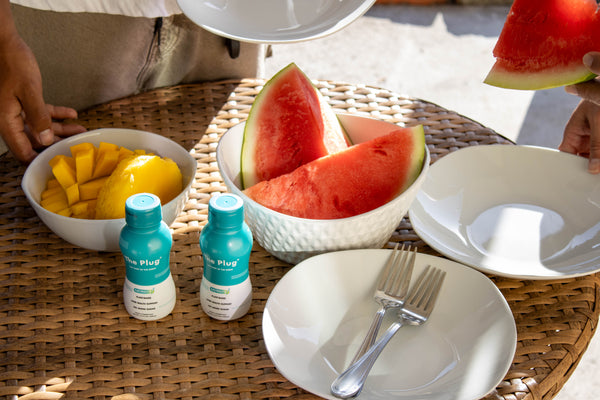cholesterol
Fiber: The Benefits Behind the Trend
The Plug Drink

The Plug Team

Move over, protein! Fiber has now become the newest diet trend to hit social media. “Fibermaxxing” is all about increasing one’s fiber intake to improve their gut health and lose weight (1). But besides it being just a trend, do we actually know all of fiber’s benefits?
Let’s take protein, for example. Protein has been a huge topic in the diet and wellness world in recent years. However, according to the 2025 IFIC Food & Health Survey, while 70% of Americans are trying to increase their protein intake this year, the same survey reveals that many may lack knowledge on the effects of the macronutrient, the quality and types of proteins, and one’s daily needs (2). So with all this to say, are we paying attention to what we’re putting in our bodies? Or are we just rolling with the trend and hoping for the best?
So, before anyone starts overloading on fiber, let’s take a look at what exactly it is and its benefits. Because while fiber is great for gut health and can promote weight loss, it plays a crucial, overlooked role in supporting the rest of our bodies, including the liver.
So, What Exactly Is Fiber?

Fiber is a type of non-digestible carbohydrate found in plant-based foods. Now, don’t freak out — carbs are not the enemy! We need carbohydrates as our main source of energy and to help the liver detoxify the body (3).
There are two types of fiber:
● Soluble: These fibers absorb water during digestion, turning into gel. This process slows digestion and can decrease blood sugar and cholesterol levels.
● Where to find it: fruits, vegetables, legumes (e.g., beans, lentils, and peas), barley, oats, nuts, and seeds (4).
● Insoluble: These fibers do not absorb water during digestion, adding bulk to stool. Insoluble fibers help keep bowel movements regular, preventing constipation.
● Where to find it: fruits, vegetables, whole grains (e.g., whole wheat bread, pasta, and crackers), bulgur wheat, cereals, bran, rolled oats, buckwheat, and brown rice (4).
How Fiber Supports Your Liver & Body

Apart from improving digestion, fiber can do wonders for the rest of your body! Here’s how:
1. Improves Insulin Sensitivity
Along with regulating blood sugar levels, regularly eating soluble fiber can improve insulin resistance. Soluble fiber helps slow digestion, preventing blood sugar spikes. This process can help prevent type 2 diabetes and alleviate pain for those already living with the condition (5).
2. Reduces Inflammation
Fiber and proper digestion can decrease inflammatory responses in the body. The antioxidant properties in fruits and vegetables, in particular, can reduce oxidative stress, a big factor in inflammation. They also carry prebiotic fibers that promote healthy gut bacteria (6).
3. Lowers Cholesterol
Eating more dietary fiber can lower the risk and mortality from cardiovascular disease, coronary heart disease, and other cancers. Though a direct cause isn’t confirmed, the evidence supports fiber as a healthy and safe dietary recommendation (7).
4. Supports Liver Detoxification
A study showed that more fiber may help protect against non-alcoholic fatty liver disease (NAFLD). Because fiber also aids in weight management, it even more so decreases the chances of developing liver problems (8).
How Much Fiber Should I Be Eating Then?

Though we’ve discussed its many benefits, “fibermaxxing” shouldn’t be misconstrued as ingesting as much fiber as one can. There are still limits.
According to the Dietary Guidelines for Americans, adult women should strive for an intake of 25-28 grams of fiber per day, while adult men should aim for 31-34 grams daily. The amount varies depending on sex and age (9).
Overconsuming fiber or eating too much at once can lead to gas, diarrhea, and bloating. Drinking enough water is essential with a high-fiber diet to allow digestion to flow easier (10).
Beyond the Trend
If you didn’t know much about fiber before, we hope this information made it more digestible. Fiber has proven to be more than just a weight loss aid. It performs a multitude of functions to keep your entire body functioning and safe from disease.
With any diet trends on the internet, we should all be a little skeptical beforehand. It’s good to check out all of the research behind the diet to know if it’ll work for your body. And with The Plug, you’ll never have to be skeptical. We value transparency. That’s why we tell you exactly what’s in our products and provide the facts to back us up!
Bibliography
1. Stock N. Should You Be ‘Fibermaxxing’? [Internet]. The New York Times [Internet]. 2025 July 8. Available from: https://www.nytimes.com/2025/07/08/style/fibermaxxing-tiktok-trend.html
2. Americans’ Perceptions of Protein. International Food Information Council [Internet]. 2025 July;1-21. Available from: https://ific.org/wp-content/uploads/2025/07/IFIC-Spotlight-Survey-Protein-Perceptions.pdf
3. Carbs Do Not Have to Be Your Enemy [Internet]. Shore Medical Center. 2021 Nov 10. Available from: https://www.shoremedicalcenter.org/news/carbs-do-not-have-be-your-enemy
4. Increasing Fiber Intake [Internet]. UCSF Health | University of California San Francisco. Updated 2024 May 21. Available from: https://www.ucsfhealth.org/education/increasing-fiber-intake
5. 6 Benefits of Dietary Fiber [Internet]. Dignity Health. 2018 Mar 31. Available from: https://www.dignityhealth.org/articles/6-benefits-of-dietary-fiber
6. Alahmari LA. Dietary fiber influence on overall health, with an emphasis on CVD, diabetes, obesity, colon cancer, and inflammation. Frontiers in Nutrition [Internet]. 2024 Dec 12;11. Available from: https://www.frontiersin.org/journals/nutrition/articles/10.3389/fnut.2024.1510564/full
7. Barber TM, Kabisch S, Pfeiffer AFH, Weickert MO. The Health Benefits of Dietary Fibre. Nutrients [Internet]. 2020 Oct 21;12(10):3209. Available from: https://www.mdpi.com/2072-6643/12/10/3209
8. Zhu Y, Yang H, Zhang Y, Rao S, Mo Y, Zhang H, et al. Dietary fiber intake and non-alcoholic fatty liver disease: The mediating role of obesity. Frontiers in Public Health [Internet]. 2023 Jan 5;10. Available from: https://www.frontiersin.org/journals/public-health/articles/10.3389/fpubh.2022.1038435/full
9. Dietary Guidelines for Americans 2020-2025. U.S. Department of Agriculture and U.S. Department of Health and Human Services [Internet]. 2020 Dec. Available from: https://www.dietaryguidelines.gov/sites/default/files/2021-03/Dietary_Guidelines_for_Americans-2020-2025.pdf
10. Vo JK. Nutrition & Health Info Sheets for Consumers - Fiber [Internet]. UC Davis Nutrition Department. 2018. Available from: https://nutrition.ucdavis.edu/outreach/nutr-health-info-sheets/consumer-fiber
